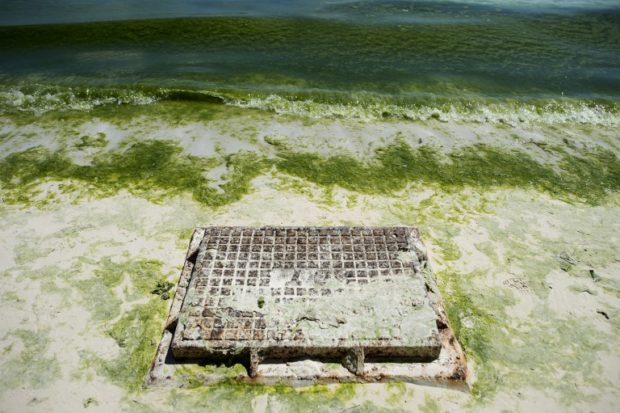
Green algae can be seen on the bay of Boracay on April 24, 2018, ahead of its closure. President Rodrigo Duterte ordered the once-idyllic white-sand resort closed to tourists for up to six months, staring on April 26, after describing the country’s top tourist attraction as a “cesspool” tainted by raw sewage. (Photo by NOEL CELIS / AFP)
A state of calamity to justify the closure of Boracay to visitors could remain in force for more than six months, according to a proclamation signed by President Duterte.
Proclamation No. 475 issued on Thursday, the first day of Boracay’s closure, detailed the environmental degradation in the three barangays on the island.
It did not set a date for when the state of calamity declaration would be lifted.
“The state of calamity in the Island of Boracay shall remain in force and effect until lifted by the President, notwithstanding the lapse of the six-month closure period,” the proclamation said.
The proclamation allows concerned government agencies to control the prices of basic goods and commodities for the affected areas, employ negotiated procurement, and use disaster funds for relief and rehabilitation efforts in the area.
Investigation findings
The proclamation listed the findings of the investigation into the state of Boracay.
High concentration of fecal coliform in Bolabog beach in the eastern side of the island due to insufficient sewer lines and illegal discharge of untreated wastewater.
Most commercial establishments and residents are not connected to the sewerage system.
Only 14 out of 51 establishments near the shore comply with the Clean Water Act.
Dirty water being discharged has resulted in the degradation of coral reefs and coral cover.
Ninety to 115 tons of solid waste are generated a day, but the government could only haul 30 tons a day.
Natural habitats of “puka” shells, the nesting ground of marine turtles and the roosting grounds of flying foxes or fruit bats have been damaged or destroyed.
Only four out of nine wetlands remain due to illegal encroachment of structures, including 937 structures on forestlands and wetlands, and 102 in areas classified as easements.
The disappearance of the wetlands, which act as natural catchments, contributes to flooding on the island.
It said “urgent measures” were needed to arrest the “human-induced hazards” to protect the health of the public and to rehabilitate the island.